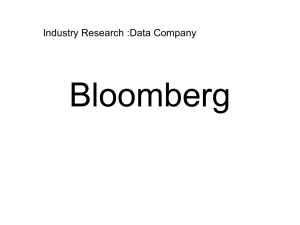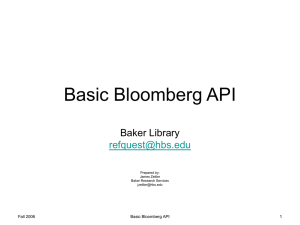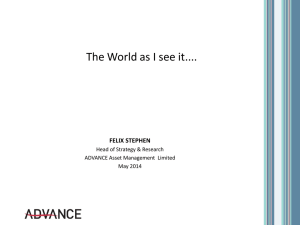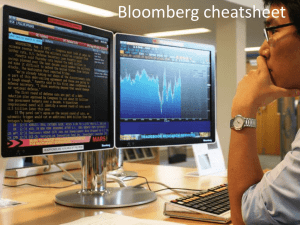Indicators Construction and Interpretation
advertisement
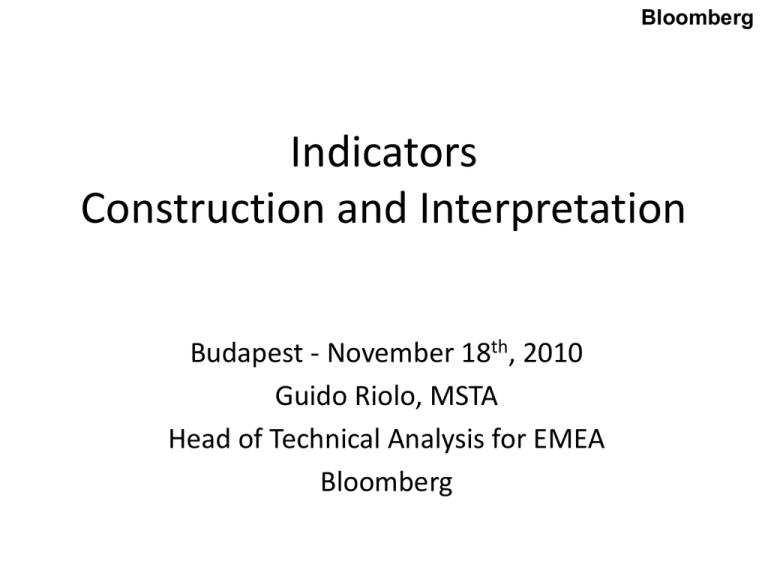
Bloomberg Indicators Construction and Interpretation Budapest - November 18th, 2010 Guido Riolo, MSTA Head of Technical Analysis for EMEA Bloomberg Bloomberg What is Technical Analysis? Definition: The study of “market action” primarily through the use of charts for the purpose of forecasting future price trends. Market action refers to: 1. Price – what does it cost? By far the most important 2. Volume – how many people are buying/selling? Secondary info 3. Open Interest – number of existing contracts in the market (futures and options) 4. Other data sets like Put/Call ratio and Volatility Based on three premises. Bloomberg Three Premises of T.A. 1. Market Actions Discount Everything Anything that can influence the price of a security is reflected in the current price. Therefore knowing why a price goes up or down is not important. For example, earnings, politics, management changes, legal activity Bloomberg Three Premises of T.A. 2. Prices Move in Trend Newton’s first law states “An object in motion continues in motion unless acted upon by an unbalanced force.” Think of this as changes in supply and demand Leads to the saying “The trend is your friend” Bloomberg Three Premises of T.A. 3. History Repeats Itself The key to understanding the future lies in the study of the past. Chart patterns have been identified that reflect changes in future prices Head and shoulders, flags, double tops / bottoms, et cetera Bloomberg But does it work? And if it does, why? Two main questions: 1. Do prices trend? Prices trend because human activities are cyclical, as a result interest rates, economic activities and market prices are also cyclical Bloomberg Bloomberg Bloomberg But does it work? And if it does, why? Two main questions: 1. Do prices trend? 2. Are we irrational? We have three structures in the brain: Cerebrum, Cerebellum and Limbic System. They are progressively older in evolutionary terms and deal with progressively less sophisticated issues. In the limbic system the Amygdala deals with emotions, in particular fear, processing of rewards, aggression and emotional memory. Do we trade with the Cerebrum or with the Amygdala? Bloomberg Types of Charts Line vs. Bar vs. Candle High High Close Close Open Open Low Low High Open High Close Open Close Low Low Bloomberg Types of Charts Point and Figure – a series of columns full of either X’s or O’s representing rising and falling price respectively. 25.00 24.00 X X X 23.00 X O X O X O X 22.00 X O X O X O X X O X O 21.00 X O X 20.00 X O X O X O X 19.00 X O X O X O X 18.00 X O X O O 17.00 X O X 16.00 X O 15.00 X O 14.00 X O 13.00 X X O X O X O X O X X O X O X O X O X O X O X O X X O O X O X O X O X O X O X O X X O X O X 12.00 X O X 11.00 X O 10.00 X Bloomberg Basic Concepts Trend Line – a line drawn on a chart connection two price points to estimate support, resistance, and confirm a change in trend Support – is found in an uptrend as an upward sloping or horizontal line serving as “support” for a price correction Resistance – is found in a downtrend as a downward sloping or horizontal line serving as “resistance” for a price rally. Channel – a support and resistance line combined Bloomberg Bloomberg Bloomberg Bloomberg Moving Averages A moving average is simply the price of a security smoothed out over time. It is called a “moving average” because each point on a moving average refers to a set number of historical prices. A 50 day SIMPLE moving average refers to the average of the closing values for the last 50 days. Common moving averages are 50-200, 15-50, 5-30 Buy signal is generated when Price crosses above a moving average A shorter term moving average crosses above a longer term moving average Sell signal is generated when Price crosses below a moving average A shorter term moving average crosses below a longer term moving average Bloomberg Moving Averages Bloomberg ATR: Average True Range The True Range for a day is defined as the greater of the three values: Current High – Current Low Previous Close – Current Low Current High – Previous Close This means that the True Range will be daily range plus any prior gap From a psychological point of view, the gap is assigned to the following day Bloomberg ATR: Average True Range We then take the average (simple or exponential) of the True Range Ideally the ATR will expand in a trending phase Best use of the ATR is to calculate a trailing stop Since the ATR is the “normal” current volatility, if the market goes against us by more than the value of the ATR, then we should close the position Bloomberg Bloomberg DMI: Directional Movement Index We start with the Average True Range If the new bar has higher highs and higher lows, the change in highs goes to +DM If the new bar has lower lows and lower highs, the change in lows goes to -DM If the new bar has lower lows and higher highs, it depends on which one’s larger +DMI is average of +DM / ATR; -DMI is average of –DM / ATR ADX is average of difference of +DMI and –DMI over the sum of +DMI and -DMI ADXR is the midpoint between 2 ADX readings Bloomberg DMI: Directional Movement Index +DMI gives us the strength of the uptrend component -DMI gives us the strength of the downtrend component ADX gives us the overall strength of the trend ADXR confirms the strength of the signal provided by ADX If +DMI>-DMI, moves up are more convincing than moves down If –DMI>+DMI, moves down are more convincing than moves up If ADX is greater than 20-25 the indication from DMI is more meaningful Ideal signals are given when ADX is greater than 25 and rising Beware of divergences and extreme readings Bloomberg Bloomberg Ichimoku Kinko Hyo: At a glance Created in Japan in the 1960s and therefore based on a 6-day trading week It’s the only study I have never seen anyone tinker with parameters It looks at where there is harmony in the markets The Conversion Line is the midpoint in the range covered in the last 9 periods The Base Line is the midpoint in the range covered in the last 26 periods The Leading Span 1 is the midpoint between Base and Conversion, plotted forward The Leading Span 2 is the midpoint in the last 52 periods, plotted forward The Lagging Span is the line chart of the price, plotted back Bloomberg Ichimoku Kinko Hyo: At a glance There are many ways of using this indicator. Many people use it for timing Can also be used to establish the direction of the trend and to differentiate between a correction and a change in trend In a trend, you would expect both price and Lagging Span on the same side of the cloud When Lagging Span and price are not in agreement, the trend is identified by the position last time they were in agreement Quite often corrections find support or resistance at the Conversion or Base Bloomberg Bloomberg Stochastics It is often divided into Fast, Medium and Slow Stochastic It assumes that trending markets can consistently close near the extreme prices When a rally cannot close near the high, the trend might be in danger It’s an oscillator and therefore tries to identify tops and bottoms It is best used in a sideways, oscillating market It compares the last price with the overall range covered in the last X periods It then calculates a number of subsequent moving averages of the %K line The signal is given when %K and its moving average %D cross in extreme territory (overbought or oversold) and then both come out into the neutral area Bloomberg Bloomberg MACD: Moving Average Conv-Div One of the most complete indicators, it is based on Moving Averages It is trend following but improves timing when compared with MAs It gives divergences like an oscillator At the core there are three exponential Moving Averages We take a 12 and a 26 day Moving Averages of the closing prices We then calculate the difference, by taking the slower out of the faster (12-26) We then calculate a 9 day EMA of the resulting line We finally calculate the difference between the first line (MACD) and the second (Signal) and plot it as a histogram (MACD2) Bloomberg Bloomberg MACD: Moving Average Conv-Div In a sustained trend the fast MA moves away the slow MA, towards the price This causes the MACD line to move in the direction of the trend The MACD moving away from the Signal is identified by a bigger histogram As an uptrend slows down, it still records new highs, but without pulling away from its MA, and that causes a divergence The MACD line measures the speed of movement. The MACD2 the ability of the MACD to move away from its MA In a sideways market it will give you many false signals Its indications can be used selectively. If the trend is up, a sell indication is a great point to take partial profit, the successive buy can then be used to accumulate Bloomberg RSI: Relative Strength Index Quite possibly the most widely used indicator …and the one with the most misleading name It is an oscillator and it’s great at identifying divergences If you use it for trading timing, use multiple timeframes (3-9-14 is very popular) It is the relative strength of the uptrend supporters vs. the downtrend ones It compares the money made by buyers when the price went up to the money made by sellers when the market was down. Divides them by the overall number of periods in the interval (not just the ones up or down) and makes a ratio. Finally, brings it in a closed scale between 0 and 100 When too much money is made on one side if compared to the other, the market is not balanced and a correction might be coming Bloomberg Bloomberg Parabolics SAR Great tool to use to identify objective exit points Great in fast, trending markets… …dangerous in sideways ones SAR should not override one’s target but complement it I personally prefer using it one time degree higher (i.e. if my entry is decided on a daily chart, I look at the weekly Parabolic to decide when to leave) Beneficial feature: it allows the new trend to develop, the other side of the coin is that it does not give much space to corrections to develop Bloomberg Parabolics SAR First SAR is placed at the extreme price of the previous move (i.e. at the start of an uptrend the first support is given by the previous reaction low) We then take 2% (AF, acceleration factor) of the distance between the previous SAR and the “extreme price” (highest high) reached so far. We then add this to the previous SAR to calculate the new SAR In order to make it parabolic, every time there is a new extreme price, the AF is increased by 2%, up to a max of 20% The only exception occurs when tomorrow’s SAR would fall into today’s* range When the price hits the current SAR, the position is stopped and reversed If you follow this rule very strictly, your broker will be extremely happy, but use it wisely, and it can take you out of trouble when discipline has abandoned you * Or yesterday’s Bloomberg Bloomberg Bloomberg Rate of Change & Momentum They are the most basic oscillators, comparing the current price with the close X periods ago. Periods used tend to be harmonics of 20 (the trading month) or Fibonacci numbers (just like for the moving averages) The only difference between the two is that ROC expresses this change in percentage terms while Momentum shows it in absolute value. The two lines will look exactly the same in the short run, but substantially different in the long run Position relative to the 0 line give the direction of the trend, the slope of the line indicates the speed Therefore a positive Momentum line pointing down indicates that the current uptrend is slowing down They can also be used to identify extreme readings and divergences Bloomberg Bloomberg Bloomberg Bloomberg Contact Details: Guido Riolo<MSG> on Bloomberg guidoriolo@bloomberg.net +4420 7330 7211 All opinions expressed are my own and do not reflect the opinions of my employer. All examples used and indications given are for educational purposes only and are not meant to be an indication to buy, sell or otherwise trade any security. All indicators will occasionally give false trading signals and they should only be used after careful consideration of their behaviour and of their possible consequences.


